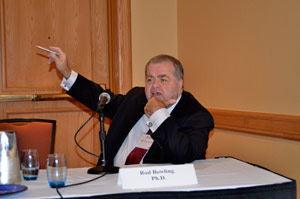ILC–USA 2012:
North America's Competitiveness
in the Global Market
by Kasey Miller for Angus Productions Inc.

Rod Bowling photos by Kasey Miller
DENVER (Jan 10, 2012) — “It’s the three of us against the world,” said Rod Bowling, AgriFood Solutions International, College Station, Texas, of the United States, Canada and Mexico at the 2012 International Livestock Congress–USA (ILC–USA 2012) in Denver, Colo., Jan. 10.
In a panel moderated by Paul Clayton, of the U.S. Meat Export Federation (USMEF) in Denver, Colo., Bowling and Mike Smith of Harris Ranch in Selma, Calif., discussed the North American countries’ strengths, weaknesses, opportunities and threats in the categories of environment and sustainability, food safety, foreign animal disease, traceability, product availability, and availability of educated and experienced employees.
Bowling suggested that North America needs to work on becoming energy-independent. Canada has an island economy from a food and energy production standpoint, and he said that there is no reason why we shouldn’t be the next OPEC (Organization of the Petroleum Exporting Countries) for food, though the biggest issue is water. Recharging the Ogallala aquifer and conserving water are the biggest challenges for environmental sustainability.
On sustainability, Bowling asserted that there is nothing unsustainable about ruminant animals. In the production of a steer, only about 14% of nutrients come from grain or concentrates. When you compare the grass-heavy life cycle of beef cattle to grain-heavy cycles of pork or poultry, he said that many developing countries are making sure that they increase their cattle production, because beef has more production with a smaller footprint.
Regarding food safety, Bowling mentioned that the United States is one of the few nations in the world that deals with pathogens, but residues are the biggest issues for North American beef.
“From a food safety standpoint, in this country, we’ve gotten away from HACCP (Hazard Analysis and Critical Control Points), and we’ve become entirely too dependent upon measuring microbiological pathogens,” Bowling says. “We need to get back to basics and get away from consumer perceptions that we can measure and find them all.”
Traceability is the “hole in the bucket,” as Bowling put it. He mentioned that BSE is a slow-progressing disease, and the inability to trace it hurt the entire market. What would happen if foot-and-mouth disease (FMD) hit? “We don’t have a traceability system that’s fast enough.”

Mike Smith photos by Kasey Miller
Smith also is disappointed that the U.S. doesn’t have a traceability system. “We’ve got to have systems in place to minimize the effects of disease,” Smith added, and it is needed to maintain access to foreign markets.
The United States and Canada were working on a joint program several years ago, but the United States balked too much, so now Canada has a system and the United States doesn’t. Mexico is also working on a system.
Smith said many producers are too isolationist in their thinking, adding that many who argued for country-of-origin labeling (COOL) were adamantly against the National Animal Identification System (NAIS).
“We are severely behind the curve, especially in the North America,” Smith said. He graded each country on their traceability programs, giving Canada an A, Mexico a C and the United States an F.
One bright side about disease management, though, Clayton pointed out that North America is distinctive by its borders (including the Panama canal).
In product availability, foreign markets are developing, but the United States’ cow herd numbers are falling. Technology has helped keep beef production up, though Smith said he wasn’t sure how long technology could keep growth going without more numbers.
Available employees who are educated are plentiful, but experienced, not as much. Smith gave the example that at California Polytechnic University (Cal Poly), about 85% of the students majoring in animal science are females studying equine science or small animal pre-veterinary science. Many come from urban backgrounds.
It is heartening, he said, to see that those with urban backgrounds are getting some exposure to agriculture, though.
Smith's advice to young adults entering the work force: “Continue to be aggressive, but be flexible, too.”
Editor’s Note: The above article was written under contract or by staff of Angus Productions Inc. (API). It may not be reprinted without express permission of API. To request reprint permision, contact the editor at 816-383-5200.
This section of the API Virtual Library contains event coverage provided by the editorial team at Angus Productions Inc. (API), publisher of the Angus Journal, the Angus Beef Bulletin, the Angus Beef Bulletin EXTRA and the Angus e-List. For questions about this site, to submit an article for our consideration, or to report a broken link, contact the editor at 816-383-5200; 3201 Frederick Ave., Saint Joseph, MO 64506.
API claims copyright to this website as presented. We welcome educational venues and cattlemen to link to this site as a service to their audience.






